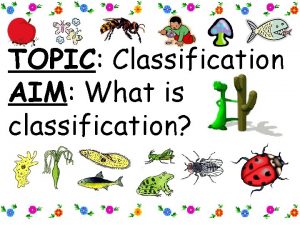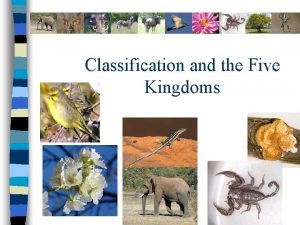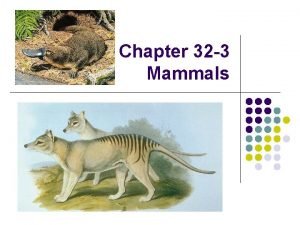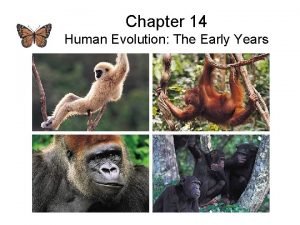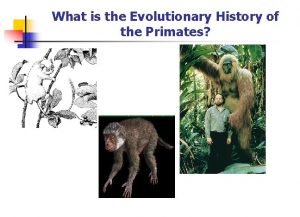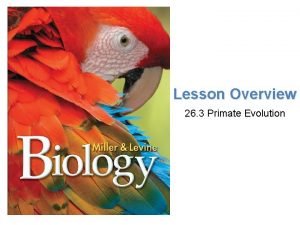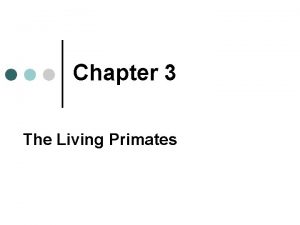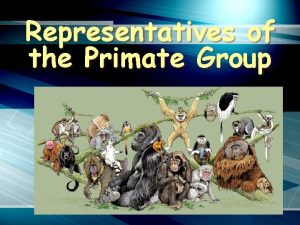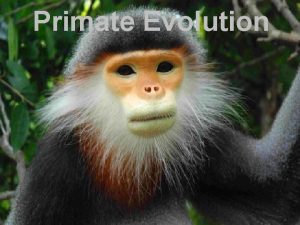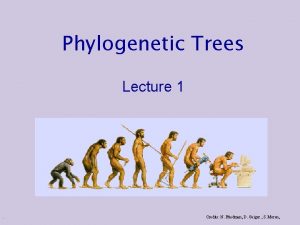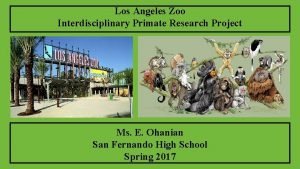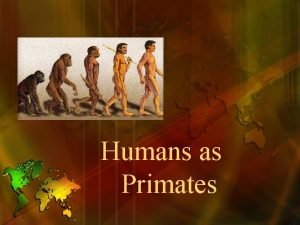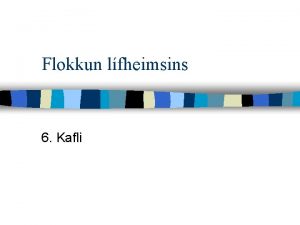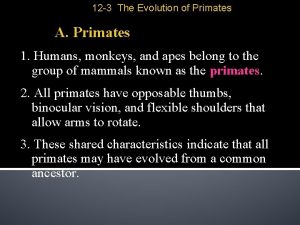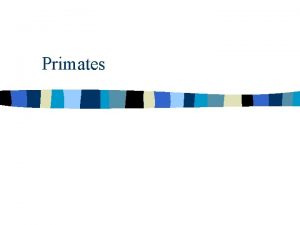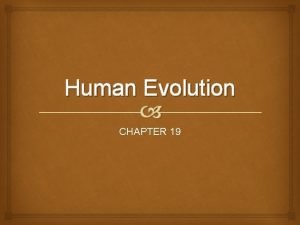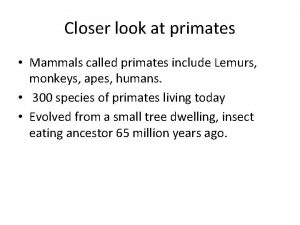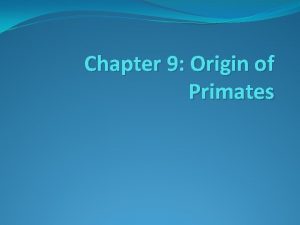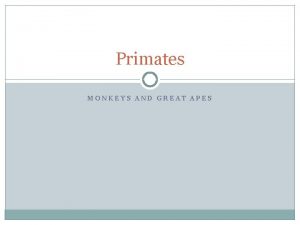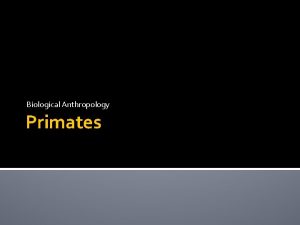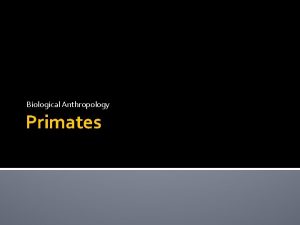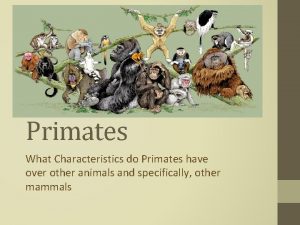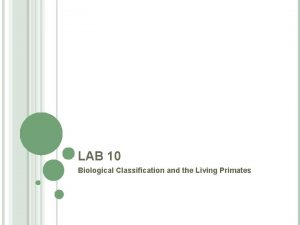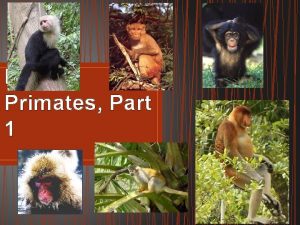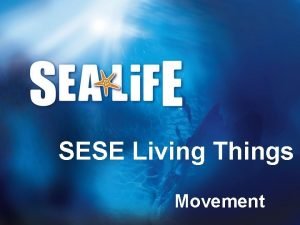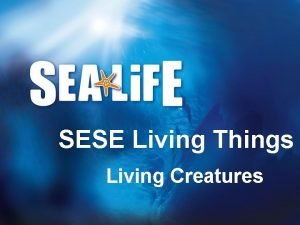Introduction to the Living Primates What is a


































































- Slides: 66

Introduction to the Living Primates


What is a Primate? • • Kingdom Phylum Class Order • • Metazoa (Animalia) Chordata Mammalia Primates

Three Primate Tendencies 1 Arboreal adaptation-primates live in the trees and are good at it 2 Dietary plasticity-primates exhibit great dietary diversity/variety 3 Parental investment-primates have fewer offspring and spend more time taking care of those offsping


Opposable Thumb


• five different types of vertebrae • great range of movement • vertically oriented trunk • preadaptation to bipedality

• dermal ridges (fingerprints) • nails instead of claws

• eyes rotated to the front of the head • color vision

• Lost naked rhinarium (wet nose) except some strepshirhines • Smell is secondary

• four functionally distinct tooth types • generalized dentition • dental formulas (# of teeth in ¼ of the jaw) – 3/1/4/3 for early mammals – 2/1/2/3 for Old World monkeys, apes and humans – 2/1/3/3 for New World monkeys (most)

Dental Specializations Insectivores-high pointed cusps Folivores-crests for shearing leaves Frugivores and seedeaters-low, round cusps

Dental Specializations (Molars) • Bilophodont molars (Old World monkeys) • Y-5 molar pattern (apes and humans)

Primate Dentition • canine-premolar honing complex • diastema

Diastema

Parental Investment in Primates • • give birth to fewer offspring investment in offspring is high development period is longer larger brain size

The Primate Brain

Brain Size and Body Size

What are the Kinds of Primates? Primate Taxonomy • Order: Primates – Suborders: Strepsirhines and Haplorhines • Strepsirhines (lemurs, lorises & galagos) • Haplorhines (tarsiers, monkeys, apes, humans)

Strepsirhines • • • large eyes and very large eye orbits rhinarium combination of nails and claws 3 premolars (2/1/3/3 dental formula) dental comb

Strepshirhine Morphology


Lemurs Madagascar

Lemurs Daubentonia: The Aye The Sifaka Black & White Ruffed Lemur

Lemurs • Found ONLY on the island of Madagascar in the wild • Great example of an adaptive radiation • Diversified on the island because they had no predators (until humans arrived and killed most of the large-bodied species) • Includes “true” lemurs, indris, and sifakas • Range in size from 2 oz (mouse lemur) to 20 pounds (indri) • Includes true lemurs, indris, and sifakas

Distribution of Lorises and Galagos

Lorises Pottos

Lorises and Galagos • Diverse group of strepsirhines in tropical Africa and Asia • Lorises are found in Africa and Asia and galagos [also called bush babies] are found in Africa only • Lorises are nocturnal; spend nights feeding on fruits, insects, and other small animals • Lorises are slow-moving, deliberate stalkers, capturing small prey • Galagos are active, leaping animals ranging in size from a house cat to a rat, and are more insectivorous than the lorises • Most species are solitary

Galagos

Vertical Clinging and Leaping

Tarsiers

Tarsiers: Who Are They Related To? Tarsiers share many characteristics with the anthropoids: • some dental features • no rhinarium • absence of tapetum lucidum • presence of fovea • blood supply around the middle ear

Tarsiers: Who Are They Related To? Tarsiers share certain characteristics with the lesser primates: • • three premolars nocturnal small brain leaping

Strepsirhines vs. Anthropoids have: • larger brains and bodies • sexual dimorphism • postorbital closure • color vision (rely less on smell) • increased parental care Also: • Anthropoids are NOT nocturnal (diurnal)


Anthropoids • New World Monkeys (Platyrrhines) • Old World Monkeys (Catarrhines) • Apes and Humans (Catarrhines)

New World Monkey Distribution

New World Monkeys (Platyrrhines) • • • Arboreal Suspensory locomotion Prehensile tail (sometimes) Diverse diet Three premolars (2/1/3/3 dental formula)

Atelidae Howler monkey Uakari Woolly monkey Spider monkey Owl monkey

Cebidae Black ear-tufted marmoset Pygmy marmoset Emperor tamarin Golden lion tamarin Capuchin Squirrel monkey

Catarrhines • Old World Monkeys (Cercopithecoids) – Cercopithecines – Colobines (leaf monkeys) • Apes (Hominoids)

Old World Monkey Distributions

Old World Monkeys arboreal AND terrestrial (some species) Ischial Callosities Cheek Pouches

Cercopithecines Baboon Macaque Guenon Mangabey Mandrill

Colobines Langur Black and White Colobus Proboscis Monkey Colobines are leaf eaters with sharp molar cusps and specialized stomachs

Hominoid Phylogeny

Apes vs. Monkeys Apes are/have: • Larger • No tail • Shortened trunk • More mobile shoulder joint: brachiation • Forelimbs (arms) longer than hindlimbs (legs) • More complex behavior and cognitive abilities (larger brains) • Increased period of development

Gibbons and Siamangs (Hylobates)

Gibbon/Siamang Characteristics • • • Southeast Asian Tropical Rain Forests Smallest of the apes Arboreal Fruit Diurnal Monogamous Paternal care of young Territorial/VERY vocal Little sexual dimorphism

Brachiation

Great Ape Distributions Gorilla: Orangutans: Pongo Gorilla Chimpanzee: Pan

Orangutans (Pongo pygmaeus)

Orangutans • Orangutans are found only on the Indonesian islands of Borneo and Sumatra • Severely endangered to due poaching by humans and habitat loss • Thus, they are the only great ape living outside of Africa • They are easily recognizable by their red fur • They live in tropical rain forest • They are mostly frugivorous (fruit-eating) • They are diurnal (active during the day) • They are mostly solitary, although females move around with their dependent offspring • First births occur when females are about 10 years old. They have one offspring per litter. Their interbirth intervals are 3 -4 years. • Orangutans live to about 50 years in the wild, and into their 60 s in captivity.

Gorilla (Gorilla gorilla)

Knuckle-Walking

Gorilla Morphology Sexual Dimorphism Saggital Crest MALE FEMALE

Gorillas • Largest of all living primates (males weigh up to 400 lbs, females 150 to 200 lbs. ) • Also highly endangered, esp. mountain gorilla-only 600 left in the wild • Found in forested areas of western and eastern equatorial Africa • Exclusively vegetarians—mountain and western lowland gorillas concentrate on leaves, pith, and stalks, but western lowland gorillas eat more fruit Gorillas move around by knuckle-walking, in which very strong arms are used to support the upper body weight while supported on the backs of the fingers’ middle phalanges. Orangutans are also knucklewalkers when they are on the ground, but they do it on a different joint (more like fist-walking). • Very high degree of sexual dimorphism in gorillas • In orangutans and gorillas males have enormous masticatory muscles, which are accommodated by a large, well-developed sagittal crest, a ridge of bone running along the midline plane of the skull. The sagittal crest is the terminal attachment site for the temporalis muscle.

Chimpanzees (Pan troglodytes)

Chimpanzees • They are both terrestrial and arboreal, spending about equal amounts of time in the trees and on the ground. • They move about terrestrial by means of quadrupedal knuckle-walking, similar to the gorillas. When on the ground they also sometimes walk bipedally for short distances when carrying food or other objects. While in the trees, they may brachiate like gibbons. • They are diurnal • Chimps are the smallest of the great apes, with females a little smaller than males • They eat a large variety of food items including fruits, leaves, insects, nuts, birds’ eggs, berries, caterpillars, and small mammals • Life span: avg. 53 years

Chimpanzee Behavior NESTS TOOL USE TERMITE FISHING

Social Behavior

Chimpanzee Behavior • They build nests for sleeping • They are famous for ‘termite fishing. ’ Termites live in mounds of dirt. In order to get termites to eat, chimpanzees use sticks to stick into the mounds and pull out termites. They will use appropriate sticks; they fid sticks that are strong enough so that they won’t break and long enough so that they reach far enough into the mound. They have also been observed to modify the sticks. If there are occluding twigs they will break them off. If the sticks are too thick, they will strip off some bark to make them thin enough to fit into the mounds. • They also use stones as hammers to crack open nuts (only in West Africa) • Spear use—to kill bushbabies (galagos)

Bonobo (Pygmy Chimpanzee) Pan paniscus

Bonobos • More slender build than common chimps, with longer limbs • Face is black from birth • Hair is ‘parted’ • Found only in parts of Democratic Republic of Congo • Unusual sexual behavior—use sex as a form of social communication

 Primate taxonomy upsc anthropology
Primate taxonomy upsc anthropology Cetacea canidae panacea ursidae primates
Cetacea canidae panacea ursidae primates Old world monkey vs new world monkey
Old world monkey vs new world monkey Order primates
Order primates Order primates
Order primates Chapter 16 section 1 primates study guide answers
Chapter 16 section 1 primates study guide answers Evolution primates
Evolution primates Purgatorius
Purgatorius Evolution of primate
Evolution of primate Primates
Primates Clasificacion de baume
Clasificacion de baume Primates
Primates Prosimian primates
Prosimian primates Evolution of primate
Evolution of primate Primates characteristics
Primates characteristics Phylogenetic tree of monkey
Phylogenetic tree of monkey What are primates
What are primates Primates characteristics
Primates characteristics Flokkun lífvera
Flokkun lífvera Are raccoons primates
Are raccoons primates Venn diagram of living things and nonliving things
Venn diagram of living things and nonliving things Is a candle living or nonliving
Is a candle living or nonliving Living non living dead
Living non living dead The smallest living unit of all living things is
The smallest living unit of all living things is Hình ảnh bộ gõ cơ thể búng tay
Hình ảnh bộ gõ cơ thể búng tay Ng-html
Ng-html Bổ thể
Bổ thể Tỉ lệ cơ thể trẻ em
Tỉ lệ cơ thể trẻ em Gấu đi như thế nào
Gấu đi như thế nào Glasgow thang điểm
Glasgow thang điểm Chúa sống lại
Chúa sống lại Các môn thể thao bắt đầu bằng tiếng nhảy
Các môn thể thao bắt đầu bằng tiếng nhảy Thế nào là hệ số cao nhất
Thế nào là hệ số cao nhất Các châu lục và đại dương trên thế giới
Các châu lục và đại dương trên thế giới Công thức tiính động năng
Công thức tiính động năng Trời xanh đây là của chúng ta thể thơ
Trời xanh đây là của chúng ta thể thơ Mật thư tọa độ 5x5
Mật thư tọa độ 5x5 Làm thế nào để 102-1=99
Làm thế nào để 102-1=99 Phản ứng thế ankan
Phản ứng thế ankan Các châu lục và đại dương trên thế giới
Các châu lục và đại dương trên thế giới Thể thơ truyền thống
Thể thơ truyền thống Quá trình desamine hóa có thể tạo ra
Quá trình desamine hóa có thể tạo ra Một số thể thơ truyền thống
Một số thể thơ truyền thống Cái miệng nó xinh thế chỉ nói điều hay thôi
Cái miệng nó xinh thế chỉ nói điều hay thôi Vẽ hình chiếu vuông góc của vật thể sau
Vẽ hình chiếu vuông góc của vật thể sau Biện pháp chống mỏi cơ
Biện pháp chống mỏi cơ đặc điểm cơ thể của người tối cổ
đặc điểm cơ thể của người tối cổ Giọng cùng tên là
Giọng cùng tên là Vẽ hình chiếu đứng bằng cạnh của vật thể
Vẽ hình chiếu đứng bằng cạnh của vật thể Phối cảnh
Phối cảnh Thẻ vin
Thẻ vin đại từ thay thế
đại từ thay thế điện thế nghỉ
điện thế nghỉ Tư thế ngồi viết
Tư thế ngồi viết Diễn thế sinh thái là
Diễn thế sinh thái là Dot
Dot Số nguyên tố là gì
Số nguyên tố là gì Tư thế ngồi viết
Tư thế ngồi viết Lời thề hippocrates
Lời thề hippocrates Thiếu nhi thế giới liên hoan
Thiếu nhi thế giới liên hoan ưu thế lai là gì
ưu thế lai là gì Sự nuôi và dạy con của hươu
Sự nuôi và dạy con của hươu Sự nuôi và dạy con của hươu
Sự nuôi và dạy con của hươu Hệ hô hấp
Hệ hô hấp Từ ngữ thể hiện lòng nhân hậu
Từ ngữ thể hiện lòng nhân hậu Thế nào là mạng điện lắp đặt kiểu nổi
Thế nào là mạng điện lắp đặt kiểu nổi Conclusion paragraph format
Conclusion paragraph format

